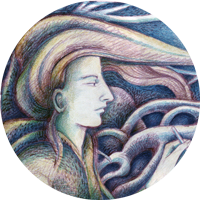 Today is the Winter Solstice, the day the sun stands still, waiting. The year hangs poised on it’s fulcrum, about to turn us once again into lengthening days and the long journey back towards the light. Today felt subterranean. Beneath a sky of grey lace, Kevin and I found ourselves on a hill beside a spring near the village of Sharpthorne, Sussex. We were there with seer and shaman, Wind Singer to bless and honour the waters, a slightly different way for me to spend the shortest day of the year.
Today is the Winter Solstice, the day the sun stands still, waiting. The year hangs poised on it’s fulcrum, about to turn us once again into lengthening days and the long journey back towards the light. Today felt subterranean. Beneath a sky of grey lace, Kevin and I found ourselves on a hill beside a spring near the village of Sharpthorne, Sussex. We were there with seer and shaman, Wind Singer to bless and honour the waters, a slightly different way for me to spend the shortest day of the year.
There is something I have always found special about bodies of water and rivers and springs are no different. Springs have been honoured for millenia – where there’s fresh water straight from the ground, it is life-giving and carries the note of the rock from where it issues, iron or other minerals which are beneficial. The waters of many springs were – and still are – believed to heal. The spring we visited today is a chalybeate spring. The word chalybeate derives from the latin word for steel which originally comes from the Greek word khalups, single for Chalybes, a mythical people who founded iron working from Mount Ida in Anatolia and where, incidently, Cybele, an Anatolian Mountain, Mother Goddess was worshipped.
In the russet landscape beneath an intensifying sky, We stood in a triangle around the spring pool. Bubbles rose up to the clear surface periodically – it seemed to be alive. Wind Singer felt the landscape energies and led the blessing. We laid holly for the male, mistletoe for the female and ivy for the light. And then we placed a woven square of twine beside the pool and scattered flowers on its surface to drift above the last water boatmen. I put my hands into the water and was surprised by its warmth and softness.
We will revisit this little spring and would like to give it a name. Something to do with Cybele perhaps, or iron or even a still, frozen sun.































 In a
In a 











